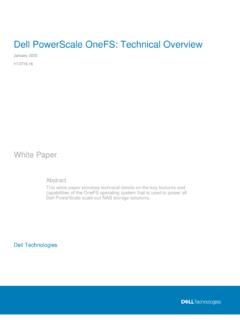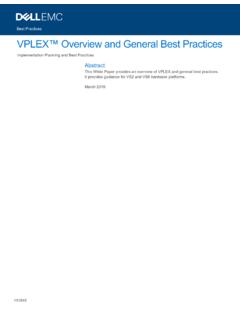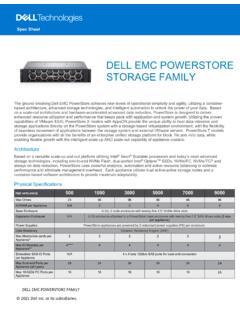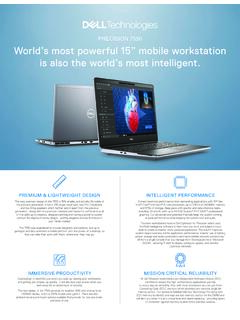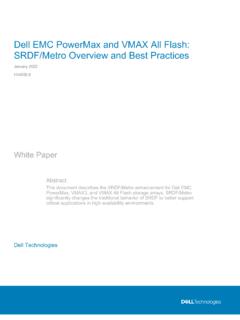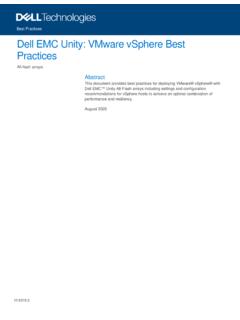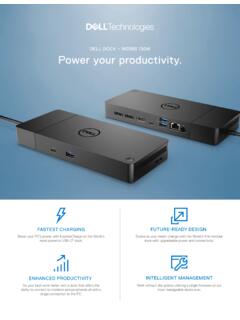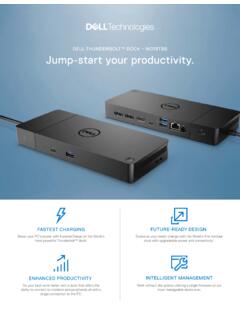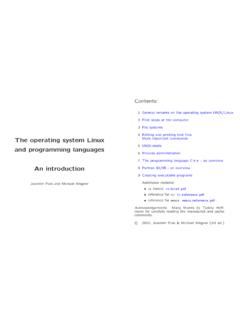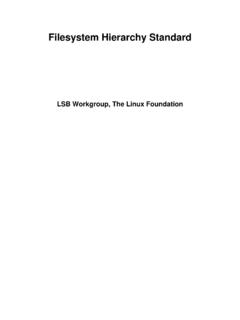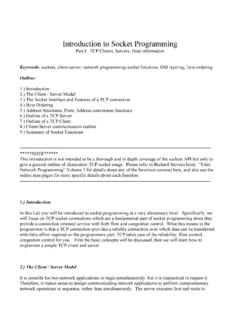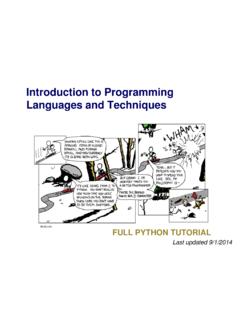Transcription of Dell EMC Unity: Introduction to the Platform
1 H15084 Technical White Paper Dell EMC Unity: Introduction to the Platform Abstract This white paper provides an overview of the Dell EMC Unity Platform . This includes Dell EMC Unity 300/F, 400/F, 500/F, 600/F, 350F, 450F, 550F, and 650F models, and the available virtual deployments of Dell EMC Unity storage. June 2021 Revisions 2 Dell EMC Unity: Introduction to the Platform | H15084 Revisions Date Description May 2016 Initial release Unity OE December 2016 Updated for Unity OE July 2017 Updated for Unity OE March 2018 Updated for Unity OE August 2018 Updated for Unity OE January 2019 Updated for Unity OE June 2019 Updated for Unity OE December 2019 vVols branding update; minor edits June 2021 Update for Unity OE The information in this publication is provided as is.
2 Dell Inc. makes no representations or warranties of any kind with respect to the information in this publication, and specifically disclaims implied warranties of merchantability or fitness for a particular purpose. Use, copying, and distribution of any software described in this publication requires an applicable software license. This document may contain certain words that are not consistent with Dell's current language guidelines. Dell plans to update the document over subsequent future releases to revise these words accordingly. This document may contain language from third party content that is not under Dell's control and is not consistent with Dell's current guidelines for Dell's own content. When such third party content is updated by the relevant third parties, this document will be revised accordingly.
3 Copyright 2019-2021 Dell Inc. or its subsidiaries. All Rights Reserved. Dell Technologies, Dell, EMC, Dell EMC and other trademarks are trademarks of Dell Inc. or its subsidiaries. Other trademarks may be trademarks of their respective owners. [6/17/2021] [Technical White Paper] [ ] Table of contents 3 Dell EMC Unity: Introduction to the Platform | H15084 Table of contents 2 Table of contents .. 3 Executive summary .. 4 Audience .. 4 Terminology .. 4 1 Introduction .. 6 2 Dell EMC Unity family overview .. 8 3 Hardware overview .. 9 Drive model comparison .. 10 Data-in-place conversions .. 10 Disk processor enclosure .. 11 Storage processor .. 12 SSD .. 12 Cooling modules .. 12 Battery backup unit .. 13 Baffle .. 14 DIMMs .. 14 I/O module .. 14 Power supply .. 17 Disk array enclosure.
4 17 25-drive, 2U DAE .. 17 15-drive, 3U DAE .. 18 80-drive, 3U DAE .. 18 4 Dell EMC UnityVSA .. 20 Overview .. 20 UnityVSA hardware requirements .. 20 5 Dell EMC Unity Cloud Edition .. 23 6 Conclusion .. 24 A Technical support and resources .. 25 Related 25 Executive summary 4 Dell EMC Unity: Introduction to the Platform | H15084 Executive summary This white paper provides an overview of the Dell EMC Unity Platform . This includes Dell EMC Unity 300/F, 400/F, 500/F, 600/F, 350F, 450F, 550F, and 650F models, and the available virtual deployments of Dell EMC Unity storage. For hardware details on X80/F Dell EMC Unity XT models, refer to the Dell EMC Unity XT: Introduction to the Platform white paper. For software overview on all Dell EMC Unity family systems, refer to the Dell EMC Unity: Operating Environment (OE) Overview white paper.
5 Audience This white paper is intended for IT administrators, storage architects, partners, Dell EMC employees, and any other individuals involved in the evaluation, acquisition, management, operation, or design of a Dell EMC networked storage environment using the Dell EMC Unity family of storage systems. Terminology Dynamic Host Configuration Protocol (DHCP): A protocol used to handle the allocation and administration of IP address space from a centralized server to devices on a network. Fibre Channel protocol: A protocol used to perform Internet Protocol (IP) and Small Computer Systems Interface (SCSI) commands over a Fibre Channel network. File system: A storage resource that can be accessed through file-sharing protocols such as SMB or NFS. Fully Automated Storage Tiering for Virtual Pools (FAST VP): A feature that relocates data to the most appropriate disk type depending on activity level to improve performance while reducing cost.
6 FAST Cache: A feature that allows Flash drives to be configured as a large capacity secondary cache for the pools on the system. Internet Small Computer System Interface (iSCSI): Provides a mechanism for accessing block-level data storage over network connections. Logical unit number (LUN): A block-level storage device that can be shared out using a protocol such as iSCSI. Network attached storage (NAS) server: A file-level storage server used to host file systems. A NAS server is required in order to create file systems that use SMB or NFS shares, as well as VMware NFS datastores and VMware vSphere Virtual Volumes (File). Network File System (NFS): An access protocol that allows data access from linux / unix hosts located on a network. Pool: A repository of drives from which storage resources such as LUNs and file systems can be created.
7 REpresentational State Transfer (REST) API: A lightweight communications architecture style that enables the execution of discrete actions against web services. Server Message Block (SMB): A network file sharing protocol, sometimes referred to as CIFS, used by Microsoft Windows environments. SMB is used to provide access to files and folders from Windows hosts located on a network. Terminology 5 Dell EMC Unity: Introduction to the Platform | H15084 Snapshot: A point-in-time view of data stored on a storage resource. A user can recover files from a snapshot, restore a storage resource from a snapshot, or provide access to a host. Software-defined storage: A storage architecture where the software storage stack is decoupled from the physical storage hardware. Storage Policy Based Management (SPBM): Using storage policies to dictate where a VM will be stored, as opposed to choosing a datastore manually.
8 Storage processor (SP): A storage node that provides the processing resources for performing storage operations as well as servicing I/O between storage and hosts. Unisphere : An HTML5 graphical user interface used to manage Dell EMC Unity systems. Unisphere Command Line Interface (UEMCLI): An interface that allows a user to perform tasks on the storage system by typing commands instead of using the graphical user interface. Virtual Storage Appliance (VSA): A storage node that runs as a virtual machine instead of on purpose-built hardware. vSphere API for Array Integration (VAAI): A VMware API that allows storage-related tasks to be offloaded to the storage system. vSphere API for Storage Awareness (VASA): A VMware API that provides additional insight about the storage capabilities in vSphere.
9 Virtual Volumes (vVols): A VMware storage framework which allows VM data to be stored on individual Virtual Volumes. This allows for data services to be applied at a VM-granularity level while utilizing Storage Policy Based Management (SPBM). Introduction 6 Dell EMC Unity: Introduction to the Platform | H15084 1 Introduction In this constantly changing world of increasing complexity and scale, the need for an easy-to-use intelligent storage system has only grown greater. Customers using new applications and solutions require dependable storage and are often tasked with the challenge of doing more with less. The Dell EMC Unity family addresses this challenge by packaging a powerful storage system into a cost- and space-efficient profile. Some Dell EMC Unity highlight features include the following: Dual-active architecture: Dell EMC Unity storage uses both storage processors (SPs) to serve host I/O and run data operations in an active/active manner, thereby efficiently making use of all available hardware resources and optimizing performance, cost, and density in customer data centers.
10 Truly unified offering: Dell EMC Unity storage delivers a full block and file unified environment in a single 2U enclosure. You can use the same pool to provision and host LUNs, consistency groups, NAS servers, file systems, and Virtual Volumes alike. The Unisphere management interface offers a consistent look and feel whether managing block resources, file resources, or both. A modern, simple interface: Unisphere, the Dell EMC Unity management interface, is built with the today s data-center administrator in mind. Using browser-native HTML5, Unisphere can be used across a variety of operating systems and web browsers without the need of additional plug-ins. The interface has been designed to mimic the practical flow of an administrator s daily life, organizing provisioning and management functions into easy-to-find categories and sections.

